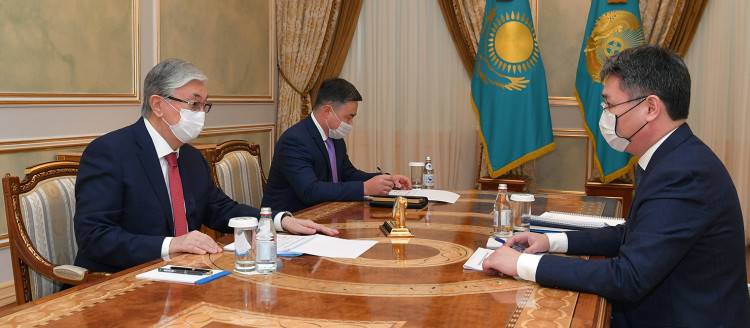NUR-SULTAN – The Kazakh Minister of Labour and Social Protection Serik Shapkenov gave his report on the employment situation in the country to Kazakh President Kassym-Jomart Tokayev April 14, reports the Akorda press service.

During the meeting in Akorda. Photo credit: Akorda.kz
Shapkenov briefed Tokayev on his ministry’s efforts to increase the incomes of the population and wages, ensuring the employment of citizens, regulating labor relations, and improving pension provision.
He also spoke about current trends in the labor market and measures to support large and low-income families.
Unemployment Rate
In 2020, the unemployment rate in Kazakhstan reached 4.9 percent, increasing by 0.1 percentage points.
The increase has been relatively good for Kazakhstan, according to experts from Kazakhstan’s Center for Development of Labour Resources.
In the United States, the rate of unemployment increased by 4.4 percentage points to 8.1 percent, while in Canada by 3.9 percentage points to 9.6 percent.
“If we consider other CIS (Commonwealth of Independent States) countries, we can see that there is an annual increase in unemployment, for example, in Armenia (by four percentage points), Azerbaijan (by 2.3 percentage points), Ukraine ( by 1.7 percentage points), Uzbekistan (by 1.6 percentage points),” said Deputy Director of the center’s Strategy and Project Management Department Alikhan Karabaev.
In 2020, 8.7 million in a country of 18 million were employed, including two million self employed citizens.
The increase in unemployment, according to the experts, can also be attributed to the consequences of the pandemic that left some citizens without jobs and forced some to suspend their work.
“The main change in the labor force is caused by a decrease in the number of employed people due to a 0.6 percent decline in the self-employed population, from 8.78 million in 2019 to 8.73 million in 2020,” said the expert.
Pensions
Between January to March 2021, the national budget allocated 205.8 billion tenge (US$477.6 million) for basic pension payments and 465.4 billion tenge (US$1.08 billion) for solidarity pension payments (for citizens with work experience prior to 1998), according to the ministry.
A nation with a population of about 18 million has more than 2.2 million citizens receiving retirement. The average pension payment amounts to 100,163 tenge (US$232) as of April 1.
In Kazakhstan, a pension payment is assigned to each person individually based on how long they have been participating in the pension system, which also includes the period prior to Jan. 1, 1998, as well as the periods that had mandatory pension contributions.
Starting this year, citizens have an opportunity to withdraw their pension savings if they exceed the sufficient amount determined by the government.
Support for low income and large families
Extending support to low income and large families, one of the most vulnerable groups of the population, has been a priority on the national agenda repeatedly voiced by President Tokayev.
The National System of Social Support for Families with Children includes six benefits and two payments providing various types of financial assistance.
In 2020, nearly 1.9 million citizens received state support from the national budget as well as from the National Social Insurance Fund, totalling 635.3 billion tenge (US$1.47 billion), which is 71 percent more than in 2019.
From January to March 2021, an average of 437,200 large families received state support totalling 69.2 billion (SU$160.6 million) tenge.
Families with four or more minors or full-time students up to the age of 23 may be eligible for this support regardless of their income, thanks to the new rule in effect since January 2020.

